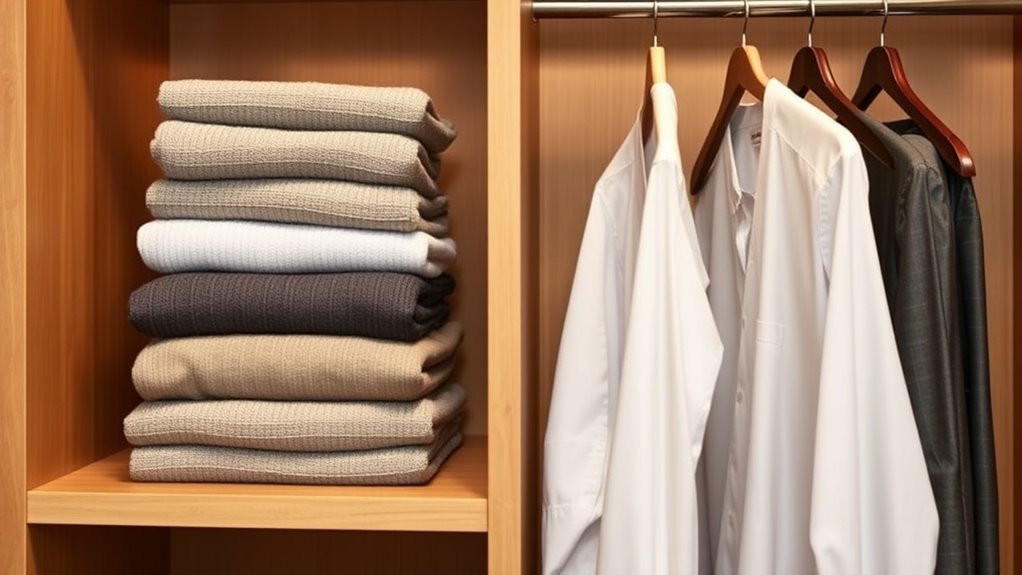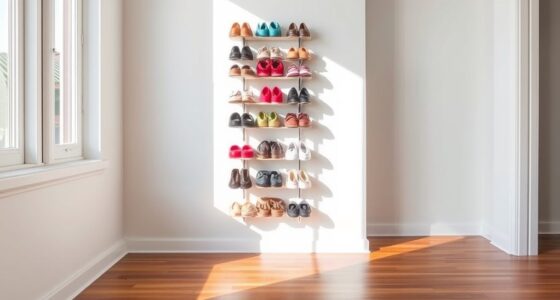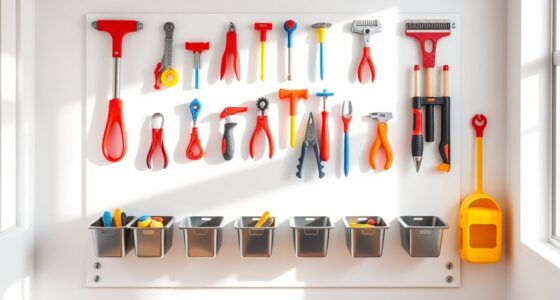To maximize your closet capacity, use a mix of folding and hanging, based on each item’s needs. Fold bulky clothes like t-shirts and sweaters to save space, and hang items prone to wrinkling or worn frequently for easy access. Incorporate clear storage bins and color coding for quick identification, creating an organized and efficient system. Continuing to explore these strategies will reveal even more ways to optimize your closet scientifically and effectively.
Key Takeaways
- Folding maximizes vertical space and prevents bulky piles, ideal for t-shirts, sweaters, and jeans.
- Hanging minimizes wrinkling and provides quick visibility of frequently used or delicate items.
- Combining both methods allows for personalized organization, optimizing space based on item type and usage.
- Uniform hangers create a streamlined look, making it easier to scan and access hanging clothes efficiently.
- Using storage bins for folded items and color coding enhances organization and quick retrieval, increasing closet capacity.

Organizing your closet can be a game-changer for maintaining a tidy and accessible space. When you take the time to implement effective strategies, you’ll find it easier to locate what you need and keep everything in its proper place. One key aspect of maximizing your closet’s capacity is understanding how to best utilize storage bins and color coding. These tools aren’t just about aesthetics—they serve a practical purpose rooted in science. Storage bins help compartmentalize items, reducing clutter and making it easier to see what you have at a glance. When you use clear or labeled bins, you minimize the time spent rummaging through piles of clothes or accessories. Furthermore, storage bins can be stacked efficiently, saving vertical space and allowing you to maximize every inch of your closet. Additionally, choosing the right contrast ratio in your lighting setup can make your closet appear more spacious and visually appealing. Color coding, on the other hand, is a simple yet powerful method to enhance organization. By assigning specific colors to different categories—like blue for casual wear, red for work attire, or green for seasonal items—you create a visual system that speeds up retrieval. This approach leverages the brain’s natural ability to recognize color patterns, making it easier to find what you need without opening multiple bins or drawers. When you combine color coding with storage bins, you create a system that’s both intuitive and scalable. For instance, using colored bins or labels inside a bin can help you quickly identify the contents without disturbing the entire organization. This method reduces decision fatigue, saving you time and effort every day. In terms of capacity, folding and hanging clothes each have their best uses, but the way you organize them can influence your closet’s overall efficiency. Folding clothes neatly and stacking them within labeled storage bins prevents bulky piles from taking up unnecessary space. This is especially effective for items like t-shirts, sweaters, and jeans. Hanging clothes, by contrast, are best for items prone to wrinkling or that you wear frequently, such as dresses, shirts, and suits. When you hang these items using uniform hangers, it creates a clean, streamlined look that also makes scanning for specific pieces effortless. Combining both methods—folding some items into labeled, color-coded bins and hanging others—allows you to tailor your closet to your lifestyle and maximize capacity. Ultimately, the goal is to create a system that’s easy to maintain. Using storage bins and color coding helps you stay organized and prevents clutter from creeping back in. By strategically folding and hanging your clothes, you ensure that your closet remains functional, accessible, and efficient. When you implement these scientifically-backed organization techniques, you’ll find your space feels larger, more inviting, and perfectly tailored to your needs.
Frequently Asked Questions
Which Clothing Types Are Best Suited for Folding?
When deciding which clothing types are best suited for folding, consider the clothing material and folding techniques. Soft fabrics like t-shirts, sweaters, and casual tops fold easily and stay neat when folded correctly. Use proper folding techniques to prevent wrinkles and save space. Avoid folding delicate or structured garments like suits or dresses, which tend to lose shape. Folding these items maximizes your closet capacity while keeping your clothes in good condition.
How Does Fabric Type Influence Folding and Hanging Choices?
Think of your wardrobe like a garden; each fabric type needs specific care. For delicate fabrics like silk, hanging prevents creases and maintains material integrity, while sturdy materials like denim benefit from folding to avoid stretching. Fabric care and material durability guide your choices—hanging preserves fragile items, while folding enhances durability for heavy-duty fabrics. Adjust your approach based on these factors to keep your clothes looking their best.
Can Proper Storage Extend Clothing Lifespan?
Proper storage definitely extends your clothing lifespan by protecting fabric from damage. When you store your clothes carefully, you reduce wear and tear caused by dust, moisture, and pests. Using suitable methods based on clothing material and storage duration helps preserve colors, textures, and overall quality. For example, hanging delicate fabrics prevents creases, while folding sturdy items minimizes stretching. This thoughtful approach guarantees your wardrobe stays in great condition longer.
What Are Space-Saving Tips for Small Closets?
Ever wonder how to make the most of a tiny closet? You’ll want to try space-saving hacks like using vertical storage and multi-tiered hangers. Incorporate organizational tools such as stacking bins, slim hangers, or door organizers to maximize every inch. By smartly folding or hanging clothes, and keeping seldom-worn items in storage elsewhere, you’ll free up space and keep your closet neat and functional. Isn’t that a game-changer?
How Often Should Closet Organization Be Reassessed?
You should reevaluate your closet organization at least twice a year, ideally during seasonal rotation. This helps you evaluate which clothing still fits your style and lifestyle, and which items you haven’t worn in a while. Regular clothing rotation keeps your closet tidy and accessible, preventing clutter buildup. By adjusting your organization with each season, you ensure your space stays optimized and your wardrobe remains functional and inspiring.
Conclusion
Ultimately, mastering your closet is like tending a lush garden—you decide which plants (clothes) thrive folded or hanging. By choosing the right method for each item, you create a harmonious, efficient space that breathes with order and ease. Think of your closet as a well-orchestrated symphony, where every piece has its perfect spot. With a little science and a dash of creativity, you’ll turn chaos into a beautifully organized haven that works as smoothly as a well-tuned instrument.









